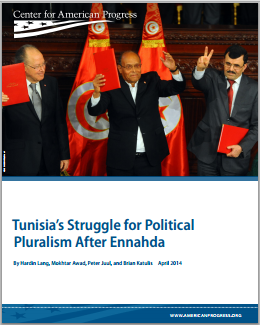Tunisia’s Struggle for Political Pluralism After Ennahda

More than three years after Tunisia ignited a wave of popular uprisings across the Arab world, the country’s transition to an inclusive democratic political system remains fragile. It is buffeted by insecurity in its neighborhood and homegrown sources of violent extremism. The economy has yet to turn the corner. Tunisia’s geographic inequalities remain acute. Despite reaching a deal on a new and relatively progressive constitution, Tunisia’s main political players remain deeply divided along Islamist and non-Islamist lines.
This report provides a snapshot of Tunisia’s political transition around the time of the third anniversary of Tunisia’s 2011 Jasmine Revolution. It examines the main Islamist and non-Islamist forces, the tensions between them, and the implications for Tunisia’s future, with a focus on Ennahda as the pivotal actor of the past two years. The report takes stock of the major trends in the Salafi community, assesses the state of Ennahda-Salafi relations, and analyzes the non-Islamist opposition. It concludes with suggested recommendations for U.S. policymakers.